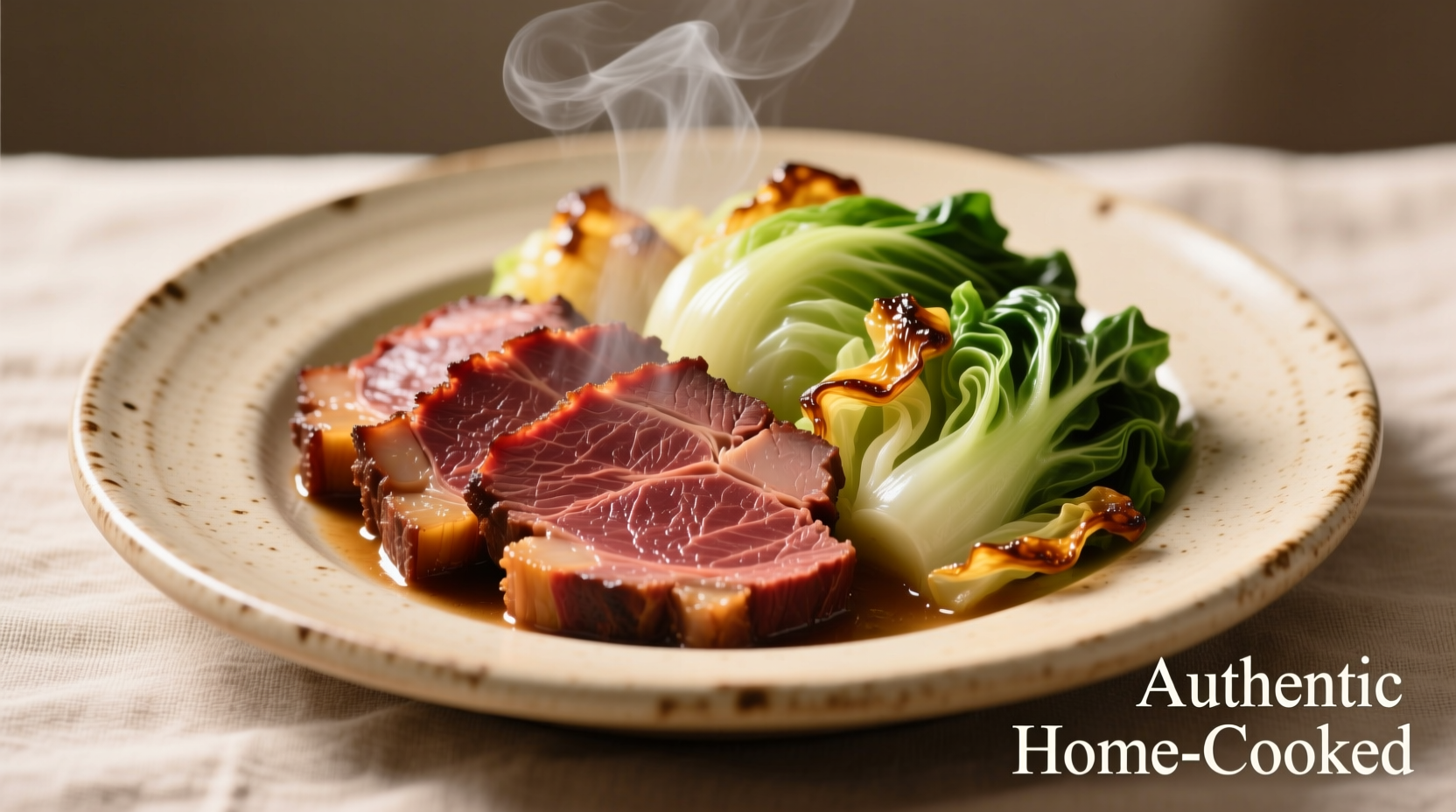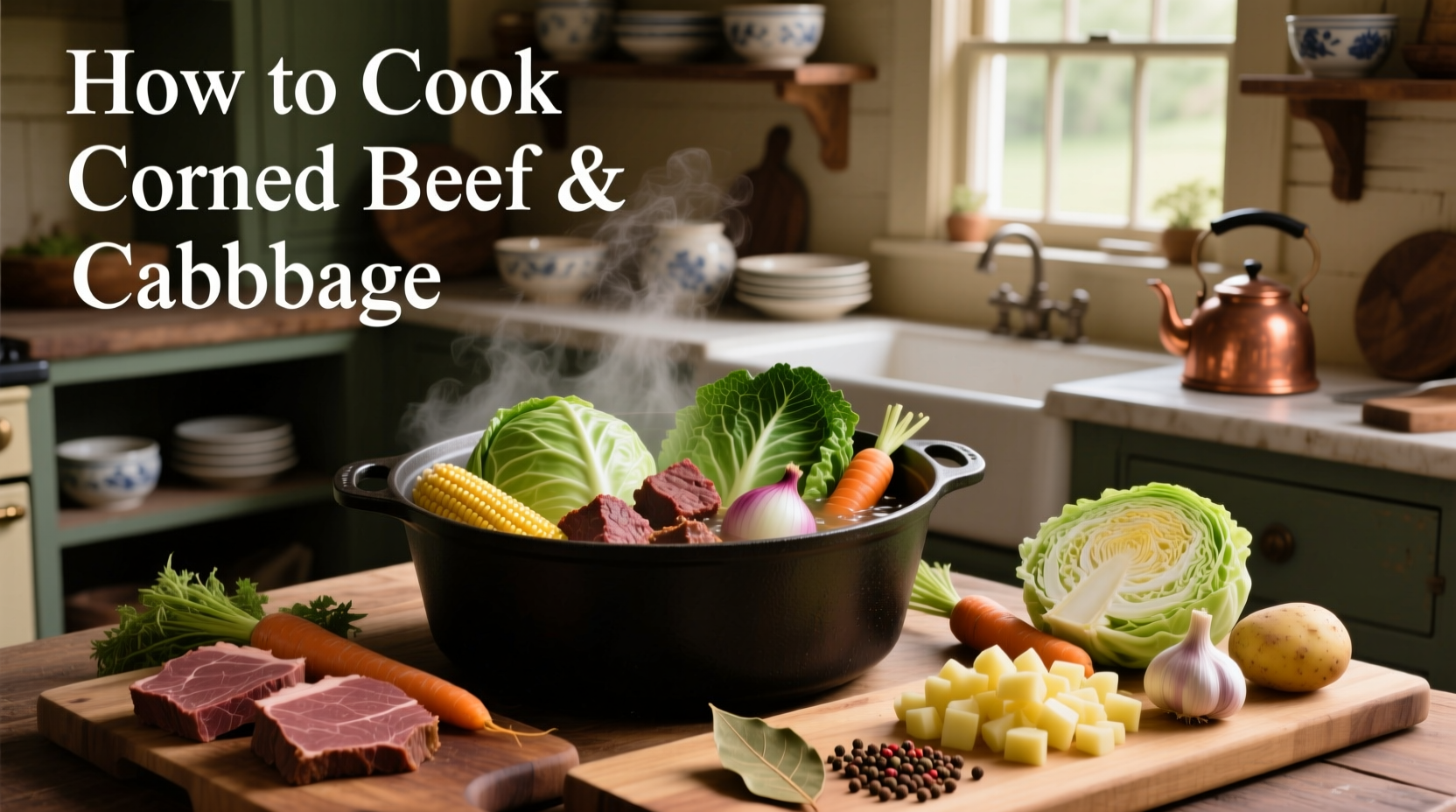The perfect method for cooking corned beef and cabbage involves simmering a 3-4 pound corned beef brisket for 2.5-3 hours until fork-tender, then adding cabbage and potatoes for the final 30-45 minutes. Key steps include rinsing the meat to control saltiness, maintaining a gentle simmer (not boil), and slicing against the grain for maximum tenderness. This traditional Irish-American preparation yields succulent meat and flavorful vegetables when executed properly.
Mastering corned beef and cabbage transforms a potentially tough cut of meat into a tender, flavorful centerpiece for your meal. Whether you're preparing for St. Patrick's Day or a comforting weeknight dinner, this guide delivers restaurant-quality results through precise timing, proper technique, and understanding the science behind the process. You'll learn exactly when to add each vegetable for perfect texture, how to test for doneness without guesswork, and professional tips that prevent common mistakes like rubbery cabbage or dry meat.
Gathering Your Essential Ingredients and Tools
Before you begin cooking corned beef and cabbage, assemble these kitchen essentials. Quality ingredients make a significant difference in the final dish, especially since this recipe has relatively few components.
For the corned beef:
- 3-4 pound corned beef brisket (with spice packet included)
- 4 quarts cold water
- 1 large onion, quartered
- 4 cloves garlic, smashed
- 2 bay leaves
- 1 tablespoon whole black peppercorns
For the vegetables:
- 6 medium potatoes, halved
- 4 carrots, peeled and cut into 2-inch pieces
- 1 small head cabbage, cut into 8 wedges
- 12 small turnips, peeled (optional)
| Cooking Method | Time Required | Texture Result | Best For |
|---|---|---|---|
| Stovetop Simmer | 2.5-3 hours | Fork-tender, traditional texture | Most reliable results, hands-on monitoring |
| Oven Braising | 3-3.5 hours | Extremely tender, slightly drier | Making multiple dishes simultaneously |
| Slow Cooker | 8-10 hours on low | Melts-in-your-mouth tender | Hands-off cooking, busy schedules |
This comparison of cooking methods for corned beef demonstrates why the traditional stovetop simmer remains the preferred technique for most home cooks. While slow cookers produce extremely tender meat, they often overcook the cabbage when added at the appropriate time. The oven method requires precise temperature control to prevent drying out the meat. The USDA Food Safety and Inspection Service recommends cooking corned beef to an internal temperature of 145°F (63°C) with a 3-minute rest period for food safety.
Preparation: Setting Up for Success
Proper preparation prevents common corned beef cooking disasters. Many beginners make the critical error of skipping these essential pre-cooking steps.
Rinse the corned beef thoroughly under cold running water. Despite concerns about losing flavor, this crucial step removes excess surface salt that can make your dish overly salty. The curing process penetrates deep into the meat, so rinsing won't affect the interior flavor. Place the brisket in a large pot (at least 6 quarts) and cover completely with cold water. Add the quartered onion, smashed garlic cloves, bay leaves, and peppercorns. If your corned beef came with a spice packet, add those now.
"Many home cooks skip rinsing the corned beef, then wonder why their cabbage turns out salty," explains Sophie Dubois, European cuisine specialist. "The surface salt needs removal, but the interior remains perfectly seasoned from the curing process."

The Cooking Process: Timing Is Everything
Follow this precise timeline for optimal results when cooking corned beef and cabbage. The sequence and timing of adding ingredients makes all the difference between a mediocre meal and an exceptional one.
- Bring the pot to a gentle simmer over medium-high heat (do not boil vigorously)
- Once simmering, reduce heat to maintain a gentle bubble (about 1-2 bubbles breaking the surface per second)
- Cover and cook for 2 hours without lifting the lid
- Add potatoes and carrots after 2 hours of cooking
- Cook for another 30 minutes
- Add cabbage wedges (and turnips if using)
- Cook for final 30-45 minutes until cabbage is tender but still holds shape
The critical mistake most home cooks make with corned beef and cabbage is adding all vegetables at the beginning. Cabbage becomes mushy and unappetizing when cooked for the full duration required for the meat. Potatoes added too early disintegrate in the broth. The staggered addition preserves each component's ideal texture.
Determining Perfect Doneness
Don't rely solely on cooking time when preparing corned beef and cabbage. Several visual and tactile indicators confirm proper doneness:
- Meat tenderness: Insert a fork into the thickest part of the brisket. It should slide in with almost no resistance.
- Internal temperature: 190-205°F (88-96°C) for optimal tenderness (higher than standard cooking temps because collagen needs extended cooking to break down)
- Cabbage texture: Should be tender but still hold its wedge shape, not falling apart
- Carrot and potato test: A knife should slide easily through with no resistance
Remove the corned beef from the pot and let it rest, covered, for 15 minutes before slicing. This resting period allows juices to redistribute throughout the meat. Slice against the grain into 1/4-inch thick slices for maximum tenderness. Serve with the vegetables and some of the cooking broth on the side.
Avoiding Common Pitfalls
Even experienced cooks encounter challenges when preparing corned beef and cabbage. Understanding these context boundaries prevents disappointment:
- Boiling vs. simmering: Vigorous boiling makes corned beef tough and stringy. Maintain a gentle simmer throughout cooking.
- Salt management: If your corned beef came pre-rinsed or you're using a low-sodium variety, you may need to add 1-2 teaspoons of salt to the cooking liquid.
- Cabbage selection: Savoy cabbage holds its shape better than green cabbage during cooking. Napa cabbage offers a milder flavor alternative.
- Timing precision: Adding cabbage more than 45 minutes before serving guarantees mushy results. Wait until the final stage.
Serving and Storage Tips
Serve your corned beef and cabbage immediately after cooking for best results. Traditional accompaniments include:
- Mustard (whole grain or spicy brown)
- Irish soda bread
- Boiled eggs with everything bagel seasoning
- Apple sauce (surprising but traditional in some regions)
Store leftovers in airtight containers in the refrigerator for up to 4 days. The flavors actually improve overnight as the meat absorbs more of the cooking broth's flavors. Reheat gently in the microwave or on the stovetop with a splash of broth to maintain moisture. Freezing corned beef and cabbage maintains quality for up to 3 months—though the cabbage texture suffers slightly upon thawing.
Historical Context of This Classic Dish
While often associated with Irish culture, corned beef and cabbage actually represents Irish-American adaptation. In Ireland, pork was traditionally the celebratory meat, while corned beef became popular among Irish immigrants in America who found beef more affordable than pork in their new homeland. The curing process ("corning" refers to the large "corns" or grains of salt used) preserved meat before refrigeration. This historical context explains why you won't find this dish commonly served in Ireland today, despite its strong association with St. Patrick's Day celebrations in the United States.
Frequently Asked Questions
These common questions address specific concerns when cooking corned beef and cabbage:











 浙公网安备
33010002000092号
浙公网安备
33010002000092号 浙B2-20120091-4
浙B2-20120091-4